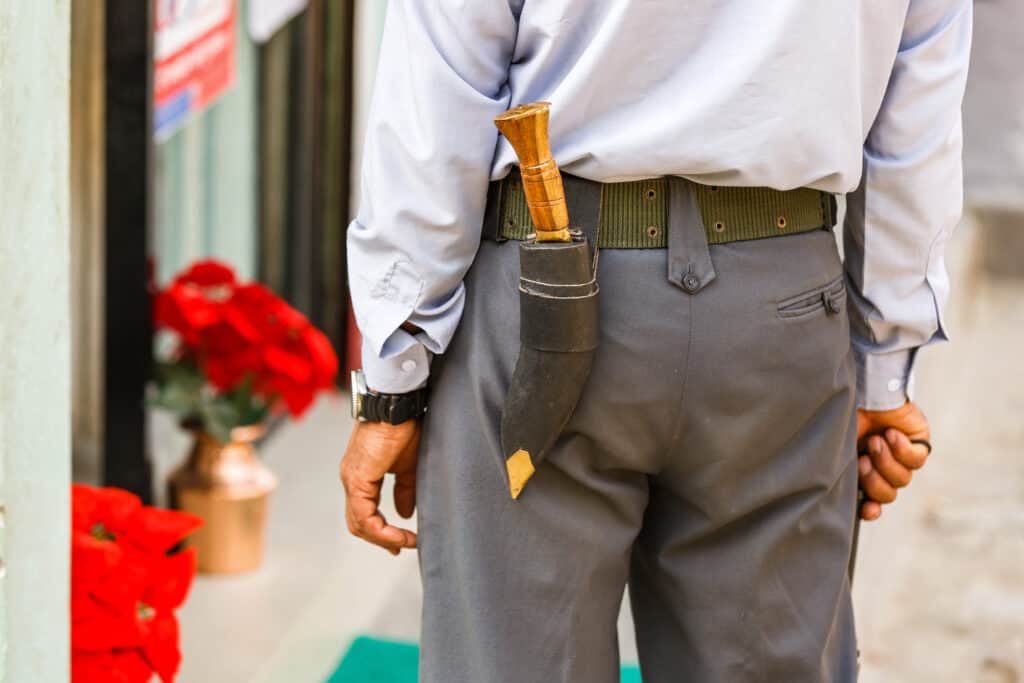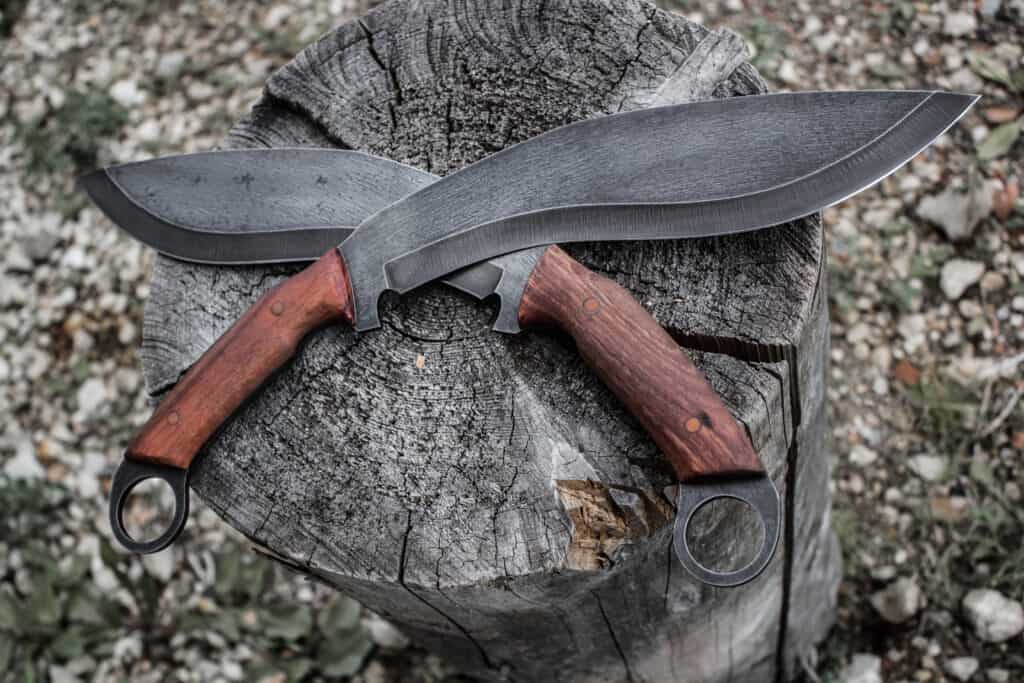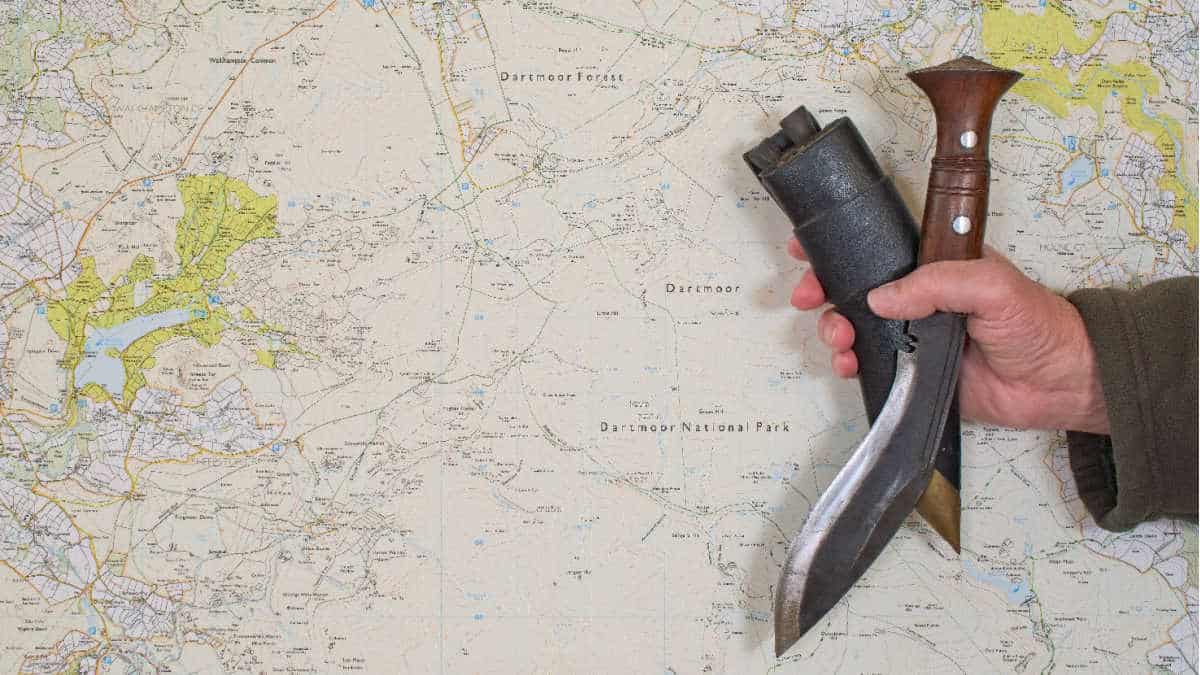As an Amazon Associate I earn from qualifying purchases.
The kukri knife is a versatile and unique tool with a rich history and various applications. Originally from Nepal, the kukri has become synonymous with the fearless Gurkha soldiers, who have wielded it in combat and earned a reputation as formidable fighters worldwide. Apart from its historical significance as a weapon, the kukri remains popular today for its diverse range of uses, from utility purposes to outdoor activities and self-defense.
Featuring a distinct curved blade, the kukri knife is designed for chopping and cutting tasks, while the mass at the center of the blade allows for deep penetration when used effectively. It is useful in various outdoor applications, such as clearing foliage, digging, and even food preparation. In addition to its outdoor functionality, a kukri knife can be employed as a viable self-defense tool, thanks to its sharp edge and versatile design.
One should note that the process of crafting a high-quality kukri often takes a considerable amount of time and skill, involving specialized blacksmiths. The end result is a dependable and versatile tool suited for a multitude of tasks, making the kukri an invaluable asset for those who possess it.
Origins of Kukri Knife
Nepal and the Kiratis
The kukri knife, also known as khukuri, is a traditional Nepalese weapon that has been used for centuries by the people of Nepal, particularly the Kiratis. The origins of the kukri knife can be traced back to the 7th century BC when the Kiratis were known to have used it as their weapon of choice. Some historians also believe that the history of the kukri knife stretches back to the time of Alexander the Great’s invasion of India, drawing comparisons with the Macedonian version of the Kopis sword.
The distinct curved blade and the unique “cho” notch on the kukri gives it a recognizable appearance, and it has since become the national knife of Nepal.
Gurkhas and British Army

The kukri knife is also closely associated with the fame of the Gurkha soldiers, who have been known for their bravery and skill in combat. The Gurkhas, originally from Nepal, have served in the British and Indian armies since the early 19th century. Their use of the kukri knife in battle has given it even greater recognition and respect around the world.
The Gurkhas adapted the kukri knife for use in various roles within the British Army, such as for combat, as a utility tool, and as a symbol of their cultural heritage. The kukri knife’s versatility has made it invaluable to the Gurkha soldiers, and it continues to be an essential part of their military service today.
In conclusion, the kukri knife’s origins can be traced back to both the Kiratis of ancient Nepal and the Gurkha soldiers who served in the British and Indian armies. Its unique design and multifunctionality have made it an essential tool for both military and everyday use, and its rich history only serves to enhance its cultural significance.
Design and Functionality
Curved Blade
The kukri knife originates from the Indian subcontinent and is known for its unique, distinct recurve in its blade. The slightly curved blade serves multiple purposes; it can be used as a melee weapon and a regular cutting tool throughout South Asia. The curved design gives the kukri knife an advantage in close combat and easy blade handling.
As a versatile tool, the kukri knife can be employed for clearing brush, self-defense, food prep, woodworking, and many other tasks. The curvature of the blade allows for increased cutting power and chopping efficiency. The kukri knife is designed for functionality and durability, making it a popular choice for various applications.
Handle Characteristics
The handle of a kukri knife is as important as its blade. It offers a secure and comfortable grip, allowing users to perform tasks with precision and ease. The handle materials can range from wood, bone, horn, or modern synthetic materials, depending on the user’s preference and the intended use of the kukri.
A well-designed kukri handle will feature:
- A strong, durable construction that can withstand heavy use and provide longevity.
- An ergonomic design that fits comfortably in the user’s hand and reduces hand fatigue during repetitive tasks.
- A secure attachment to the blade, ensuring stability and safety during use.
In addition to the primary kukri knife, some models are accompanied by supplementary tools, such as a chakmak and karda. The chakmak is a small blunt knife used for sharpening, while the karda is a small utility knife used for various tasks5. These additional tools enhance the functionality of the kukri knife set, making it an even more versatile and useful tool.
Uses and Applications
Everyday Utility Tasks
The Kukri knife is a versatile tool that can be used for various everyday tasks. With its distinct recurved blade, it is capable of performing different cutting and chopping jobs effectively. Some of the practical tasks that you can accomplish with a Kukri knife include:
- Slicing fruits and vegetables
- Cutting ropes and cords
- Clearing brush and undergrowth
- Opening packages and containers
Woodworking and Camping
When it comes to woodworking and camping, the Kukri knife serves as an excellent alternative to a hatchet or a sickle. Its unique design enables efficient use in several outdoor situations such as:
- Chopping firewood: The curved blade allows for optimal force when chopping wood, making it a valuable tool in a survival situation or during camping trips.
- Carving and shaping wood: The Kukri is a suitable choice for woodworking tasks as it can help in carving and shaping wood with precision.
- Digging: Whether you’re digging up wild onions or creating a campfire pit, the Kukri knife can handle the job effectively.
Combat and Self-Defense
Originating in the Indian subcontinent, the Kukri knife has a long history of being used as a weapon in combat situations, particularly by the Nepalese Gurkha soldiers. Even though its primary use nowadays is for utility purposes, it is more than capable of being used for self-defense. The knife’s unique curved design allows for deep, penetrating wounds, making it a formidable tool in close-quarters combat situations.
Comparison with Other Knives
Machetes and Hatchets
Kukri knives, with their distinct recurved blade, offer different uses compared to machetes and hatchets. The kukri is versatile, being able to function in both utility and tactical situations. In combat situations, the kukri’s slightly curved blade provides an effective cutting edge and allows for precise control.
Machetes, on the other hand, generally have a long, straight blade with a uniform thickness. They are designed for chopping and clearing brush, making them excel in situations that require a powerful cutting force. Hatchets are smaller than both kukri knives and machetes, with a compact design focused on chopping wood or splitting logs.
The blade length of a kukri may differ from that of a machete, typically being shorter. This can make it easier to carry and more convenient for certain tasks. However, the kukri blade is often thicker than a machete’s, contributing to its uniqueness and versatility.
Bowie and Traditional Knives
The kukri knife differs from both Bowie knives and traditional knives in several ways. Bowie knives are known for their large blade and clip point, designed for various tasks such as hunting, skinning, and even self-defense. Nevertheless, their straight blade makes them distinct from the curved blade of a kukri.
Traditional knives, depending on the design, can be used for a variety of purposes like everyday tasks, camping, or even hunting. However, they may not perform as effectively in combat situations compared to a kukri knife.
The thicker, curved blade of the kukri allows for efficient cutting and chopping, whereas the blades of traditional knives and bowie knives might not provide the same level of convenience or force.
In conclusion, the kukri knife stands apart from other types of knives like machetes, hatchets, Bowie knives, and traditional knives due to its unique design and versatile uses. Its distinct recurved blade and thicker construction make it a powerful tool that excels in both utility and combat situations.
Carrying and Storage
Scabbard and Accessories
A kukri knife typically comes with a scabbard, which is a protective sheath made of materials like leather, wood, or a combination of both. The scabbard not only houses the knife but also helps in carrying and storing it safely. Traditional scabbards, like those used for the Gurkha kukri, are often made of hardwood, providing added strength and durability.
Some scabbards also include compartments for additional accessories such as a small whetstone for sharpening the blade or smaller secondary knives known as “Karda” and “Chakmak.” The Karda is used for finer tasks, while the Chakmak is typically used for sharpening the main blade and striking a flint for fire-starting.
Drawing Techniques
When it comes to using a kukri knife, it’s essential to know proper drawing techniques to prevent accidents and ensure efficient use. The curved blade design of the kukri makes it more challenging to draw than a straight-edged knife. The following are some guidelines for drawing a kukri knife from its scabbard:
- Positioning: Hold the scabbard with your non-dominant hand, with the opening slightly angled away from your body.
- Unlocking: Some scabbards have a locking mechanism to secure the blade. Gently press the lock with your thumb to release the knife.
- Drawing: With your dominant hand, grasp the handle of the kukri firmly and apply slight pressure toward the opening of the scabbard. Slide the blade out in a smooth, controlled motion.
- Safety: When drawing the knife, be mindful of the sharp edge and avoid pointing the blade toward yourself or others.
The kukri knife is not only a versatile tool with many applications, such as clearing brush, food preparation, and woodworking, but it also holds historical significance in hand-to-hand combat and stabbing techniques. Learning proper carrying, storage, and drawing techniques can help you use this iconic blade confidently and safely.
Conclusion & FAQs

Is It Legal To Carry A Kukri?
The legality of carrying a kukri varies significantly by country, state, and even city. In general, it’s important to remember that the kukri is considered a knife and falls under the same laws as any other blade. In many jurisdictions, it’s illegal to carry a knife of a certain length (often over 3 inches) without a permit or good reason. Always consult local and state laws or law enforcement agencies for accurate information.
Is a Kukri Better Than A Machete?
Whether a kukri is “better” than a machete depends on what you intend to use it for. The kukri’s design—with its curved, broad blade—is excellent for chopping and slashing, making it useful in brush clearing, chopping wood, and combat situations. The machete, on the other hand, is typically longer and thinner, making it better for slicing through dense vegetation or for use as a tool in the wilderness. Both have their strengths and uses, and the choice comes down to personal preference and situation requirements.
What Military Uses The Kukri?
The kukri is famously associated with the Gurkhas of Nepal and is the traditional weapon of the Nepalese army. It’s also used by the Gurkha regiments in the British Army, Indian Army, and the armed forces of other Commonwealth nations. The kukri serves both as a weapon and a utility tool in these forces.
Can A Kukri Cut Wood?
Yes, a kukri can be used to cut wood. The design of the kukri makes it an effective tool for chopping due to the forward drop of the blade. However, it’s worth noting that the type of wood and the size of the kukri will play a significant role in its effectiveness.
Why Do Kukris Have A Notch?
The notch on a kukri, known as a “kauda” or “cho,” serves several purposes. It’s often said to represent the Hindu goddess Kali, but it also has practical purposes: it can stop blood or sap from getting onto the handle, providing better grip and control. It can also be used to catch an opponent’s blade during combat. The precise use and significance can vary depending on the kukri’s origin and maker.
Is A Kukri A Good Fighting Knife?
The kukri has a long history as a fighting and utility knife. Its unique, forward-leaning design allows for powerful chopping and slashing strokes, making it a formidable weapon in close combat. It is also well balanced for throwing. That being said, the effectiveness of a kukri, like any weapon, largely depends on the skill of the user.
The kukri knife, often referred to as a “Gurkha blade” or “Gurkha knife”, holds a significant role in not only military applications but also in various traditional and functional aspects of life in Nepal. As a versatile tool, the kukri finds itself being used in a wide range of tasks, from building construction to clearing and cutting firewood. Additionally, it serves as a valuable instrument in food preparation, such as slaughtering animals, cutting meat and vegetables, and even opening bins.
While its primary use nowadays leans more toward utility purposes, the kukri knife remains an effective self-defense weapon when needed. Its unique design and curvature offer multifunctionality, making it suitable for a range of activities like digging and even metalwork.
Historically, the kukri has been a vital part of Nepalese culture, dating back to the 7th century BC when it was the weapon of choice for the Kiratis. Some theories even suggest a link to Alexander the Great’s invasion of India, drawing comparisons between the kukri and the Macedonian Kopis.
In summary, the kukri knife is a remarkable tool with a rich history that spans thousands of years, deeply ingrained in the Nepalese way of life. It has evolved to serve numerous practical functions, making it a prized possession for those seeking a reliable and versatile utility knife.
Do Sheepsfoot Blades Have A Purpose? (Cuz They’re Ugly…)
Spetsnaz Machetes – Blades Of The Russian Special Forces
What Is The Actual Purpose Of A Spear Point Knife Blade?
CRKT CEO Review – Coolest, Most Worthless Knife Ever?
How Sharp Is A Scalpel? (Is It Sharper Than A Razor?)
Can You Shave With A Knife? (Yes, Here’s How)
As an Amazon Associate I earn from qualifying purchases.







